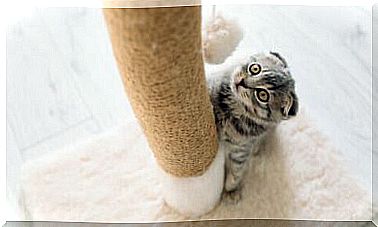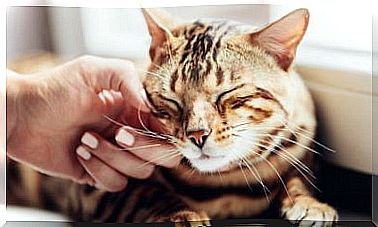Helping A Fearful Cat Overcome His Fears

The first step in helping a fearful cat to overcome his fears is to recognize the situation that scares him, a task that may not be easy; therefore, first of all you need to know your animal.
A naturally fearful cat can be afraid of many things and spend a large part of its life in hiding. On the other hand, a naturally confident cat will be less afraid and generally recover faster from a traumatic event.
The specter of fear
There are a variety of signs that help us understand if our cat is scared. Many times the trigger of feline fear is a stimulus that we can recognize.
In the case of panic, the signs may include active escape behavior and an increase in potentially harmful and out of context motor activity. The fear response is a complex conduct, involving different neuronal structures. In light of this, this response activates sensory, motor and emotional mechanisms.

The distinct manifestations of fear
Below we expose the main manifestations of response to a cat’s fear. Often, the response is defensive :
- Somatic : state of alertness (or vigilance), retracting the ears to the head, pulling out the claws, arching the back, moving the tail, showing the teeth or opening the mouth.
- Vocalizations : blowing, meowing, snorting, spitting or screaming.
- Neurovegetative (involuntary) responses : dilation of the pupils, eyes bulging, increased salivation, piloerection, increased sweating, loss of control of the urinary and anal sphincters, release from the anal glands, increased respiratory rate and heart rate.
- Movement : freezing in the place where it is, standing up, moving in circles, attacking, pawing, scratching, biting, fighting, hiding or running away.
Long-term consequences of living in fear
Among the classic signs of sympathetic activity there may be persistent diarrhea that triggers an intestinal disease of an inflammatory nature or irritable bowel syndrome. A fearful cat can also develop obsessive behaviors such as licking or biting.
How can we help a fearful cat?
If your cats are hiding but are healthy, leave them alone. They will come out when they are ready. Forcing them out of their hiding place will cause them further fear.
Make sure they have easy access to food, water and litter. Clean the litter box and change the food and water every day to find out if the animal eats and drinks.
Food strongly stimulates cats, so if your parents fear a family member, give this person the task of feeding them.

Is it possible to prevent a cat from becoming fearful?
Although there is a natural predisposition to a shy temper in some cat breeds, owners can keep the following factors in mind:
- Cats that are deprived of social and environmental exposure up to fourteen weeks of age may be routinely afraid of contact.
- Phobias and panic can result from a past inability to escape or move away from the stimulus that is causing the phobia or panic. This is why cats that have been caged or subjected to abusive conditions for a long time are more fearful.
- Cats that have been abandoned, have had multiple owners, or have been given away typically suffer from separation anxiety.
- Maintain a good state of health : any illness, intoxication or painful physical condition increases anxiety and contributes to the development of fears, phobias and anxious responses.
Diagnosis and treatment to help a fearful cat
First of all, it is necessary to discard health conditions that could be at the basis of the fearful behavior of the cat. If your vet diagnoses a simple fear, anxiety, or phobia, a professional prescribed medication may be all you need.
But there is a good chance that the vet will provide different recommendations depending on the specific case of the cat, on the trigger of the fear and on how the fears and anxiety of the feline can be calmed through the conditioning of the behavior.
To help a cat with extreme panic and separation anxiety, you need to give it protection until the medications start working, which can take anywhere from a few days to weeks. Hospitalization can often be the best option.









